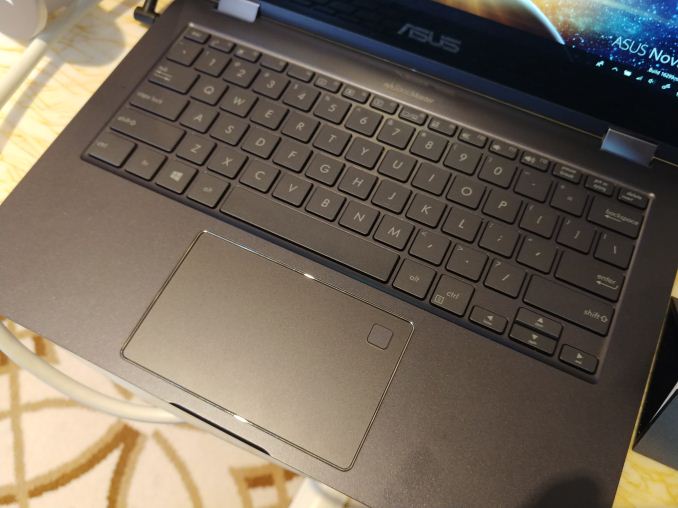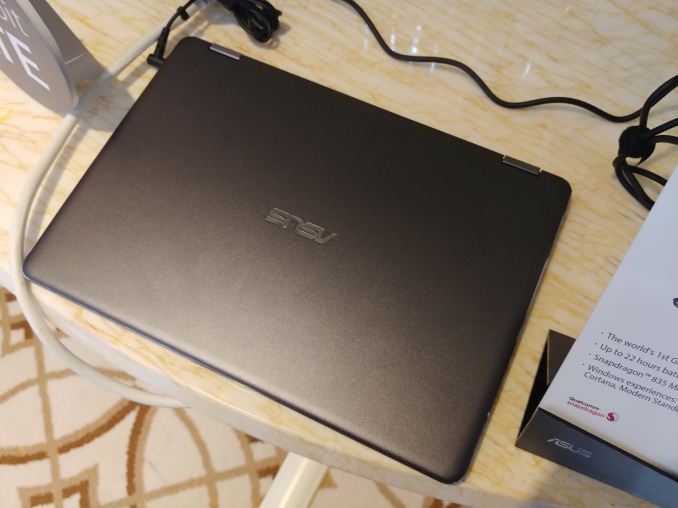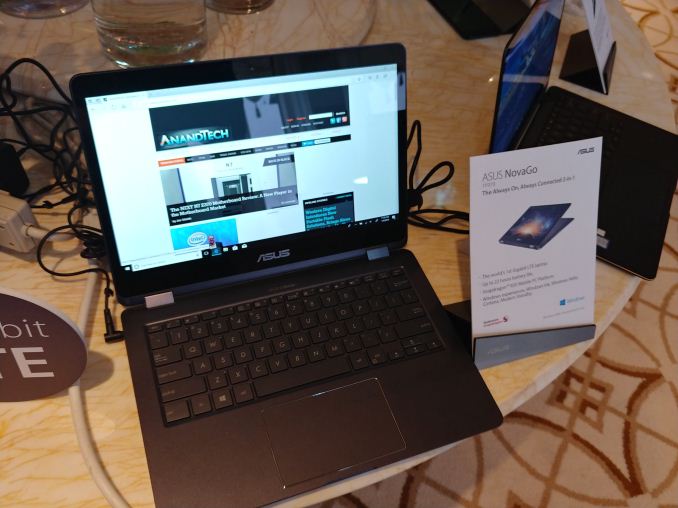The ASUS NovaGo: Two Minutes with Snapdragon 835 and Windows
by Ian Cutress on January 17, 2018 8:00 AM EST
LAS VEGAS, NV – Late last year, at Qualcomm’s Snapdragon Tech Event in Hawaii, we had the formal introduction of the first devices that were using the new Windows on Snapdragon platform and Qualcomm’s dream of bringing mobile technology to laptops to provide ‘Always Connected PCs’, connected through an LTE data connection. Qualcomm sells the upsides of this technology of providing laptops with 20hrs+ of battery life through using a smartphone processor, and through working with Microsoft, have a full version of proper Windows based on the system. The devices use native apps for best performance through the Windows Store, however 32-bit apps are machine translated into instructions that the Snapdragon SoC can process. It’s a lot of technology in a tiny device, and Qualcomm would seem to be the first CPU manufacturer to actually pull off x86 translation for the consumer market.
All of that aside, one of the first devices that should enter the market is the ASUS NovaGo. This is a 13-inch premium laptop/360-degree 2-in-1 design that has features such as Windows Hello and a fingerprint sensor built in while maintaining ASUS’ laptop quality and claiming up to 22 hours of battery life. We have wanted to get our hands on one for a while, and I managed to get a couple of minutes at the show with one at the ASUS suite.
Truth be told, the main fear that we have had with these devices is responsiveness. Smartphones on Android can be fast, with but something much bigger like Windows, it was not always on the cards that we would get the same level of responsiveness as, say, a Y-series Intel design. Back when we saw a super-early demo behind closed doors at IFA, it wasn’t the fastest, but on the NovaGo at least, everything seemed in order. Basic applications were quick and easy to open, and no visible lag from my untrained eye. Using the native compiled version of Edge, the best website in the world loaded as it normally does, and I was able to navigate the device as I would do normally with an Intel based laptop. Being familiar with ASUS’ device design, there were no surprises in the feel of the keyboard and touchpad either. Port support extends to a 3.5mm jack, a HDMI port, and two USB 3.0 ports.
A quick look through the system settings showed eight Snapdragon 835 cores, the Adreno graphics, and a PCIe based SSD for storage if I remember correctly. With it being connected to the internet, I tried downloading CPU-Z, even in 32-bit, but it required me adding it through the Store page to get it to work. Alas, the Wi-Fi at the Las Vegas Encore was not giving me any favors with the Windows Store so I was unable to go down that route, so at some point I obviously want to see the effects of x86 translation.
We were told by Qualcomm at the event a number of interesting things about the design of the platform, and how it has changed since we last met with them. Windows scheduler is configured to deal with cores of different level of performance, and it knows what programs are where and how to deal with them for performance and power, much like a good Android based scheduler. This was one of our worries, but we were categorically told that any internal worries they ever had are now fixed and it should run like a well-oiled machine.
In gaming, Qualcomm stated that with the modern APIs, the Adreno GPU is natively compiled and doesn’t need translation. As a result, due to the way that Adreno works, for some titles it ends up being more computationally efficient over other solutions and causes less work on the CPU, allowing for more of the power budget on the GPU and an overall better frame rate. Obviously we want to get a hold of the device and test the claim, but if offers an interesting prospect.
As for the NovaGo, with the addition of LTE and if it stands up to the battery life claims, it could be a neat little device depending on the price. ASUS said they expect it to launch sometime during Q2.















76 Comments
View All Comments
ezraward - Thursday, January 18, 2018 - link
Nevermind, Neowin article was wrong. See my comment below.Wolfpup - Thursday, January 18, 2018 - link
Which is aaaaawesome! I can't wait to see how well they work. And had totally forgotten that the GPU portion of the game will run the same as if it were the same GPU on an x86 CPU...that part doesn't actually matter/won't be emulated.This is what the Surface 1 and 2 SHOULD have been...just needed that x86 compatibility...
MrSpadge - Wednesday, January 17, 2018 - link
I find the comment about the Win scheduler very interesting. MS may use this opportunity to work out the quirks of scheduling for heterogenous cores, which could allow all kinds of crazyness from Intel (not really known for crazy..) and AMD (who just abandoned their small cores). Think e.g. if a machine with 2 - 4 fat "Core" cores for regular work and a bunch of the (also just abandoned) Knights-something cores for more efficiency with strongly vectorized code and/or many threads.Wolfpup - Thursday, January 18, 2018 - link
Yeah, it seems like this could have implications for x86 CPUs aimed at running real Windows. Why NOT throw in a smaller core or 4 along with your 2-8+ big x86 cores, if Windows 10 is smart enough to use them in a sensible manner.Manch - Wednesday, January 17, 2018 - link
Ill reserve judgment for the tech and its x86 translation until I can at least see some performance metrics for it. As for how it will do in the market....I'm not sure I see where this fits in. There are already regular ultrabooks and the like that get monstrous battery life with much better procs running native x86.azazel1024 - Wednesday, January 17, 2018 - link
Tablets and smaller 2-in-1s are my guess. Larger 2-in-1s and laptops...I don't see the point.Intel has basically said they've abandoned phone and tablet chips. So the newer Atom chips are running up around 5-9 watts of power. Basically they are cheaper Y series chips in terms of power use.
Cherry Trail was the last low power chip (2.5w and under) and Intel has basically said they aren't producing new stuff in that space.
Not sure what the 835 is for TDP/SDP.
Makes me sad as I really like my Asus T100h and I liked my plain Asus T100 before that. Silent running, long battery life (I can get 10-12hrs of regular, constant, use out of it before it wants to hibernate at 7% battery life remaining. Closer to 14hrs if I am watching videos off local storage), responsive. I just wish it had 802.11ac wifi. About the only real negative.
And, you know, in a year or two, a better, faster alternative in the 10" category. It means I'll probably have to move to a 12" Y series 2-in-1 eventually. Maybe AMD will come out with something in the space?
serendip - Wednesday, January 17, 2018 - link
I echo your sentiments, as a fellow advocate of Atom cheap-and-light machines. I get 9 hours on mine but it charges off USB so I can get 18 hours total runtime with an external battery pack.I think the Windows market has gotten used to sub-$500 Atom machines or full Core machines near $1000. These Snapdragon ARM machines are still cheaper than their smartphone equivalents but they're too expensive in the Windows space.
Manch - Friday, January 19, 2018 - link
That's the thing. This laptop is a 13" and the upgraded model($800) with 8GB ram etc is comparable to the Dell XPS 13 which has a similar price, has an actual x86 proc, runs 64bit applications and can do it all natively. Battery life is damn good too. At the price point of the models being released like you I don't see the point.IF the translation is as good as they say, then I wouldn't mind seeing a hybrid design. x86 proc with a companion 835 in a similar fashion to how DGPU/IGPU works when running on battery. This would allow you to greatly extend battery and still have access to everything.
Of course for that I would like to see metrics running the same scenario to see if such a thing would be worth making.
I find the tech interesting but I don't see the market in the price point its releasing at. Smaller 2 n 1s would be nice and tablets cool but at that price, Ill just get a surface 4 at a discount.
leo_sk - Wednesday, January 17, 2018 - link
Whats exactly is the role of windows store? Is it impossible to sideload apps?domboy - Wednesday, January 17, 2018 - link
If you switch it from Windows 10 S to Pro (for free) within 180 days you won't even need the store if you don't want it.